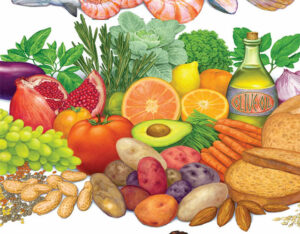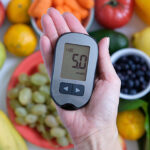THE MEDITERRANEAN DIET FOR BETTER BLOOD PRESSURE

Everybody knows reducing salt consumption can lower blood pressure, but the eating pattern you follow can enhance the blood pressure lowering effect for even better results. Globally, the DASH (Dietary Approached to Stop Hypertension) diet is one of the better-known blood pressure lowering diets, but the good old Mediterranean Diet is just as good, if not a little better according to recent research (1). And a lower GI eating pattern can also help (2). It turns out that good blood pressure and heart health can be achieved through the power of beneficial foods as well as reducing the less healthy foods, or in other words enjoying an overall healthy diet. This positive power of healthy food resonates well for holistic health as well.
A plant-rich diet contains plenty of potassium, which helps to counter the adverse blood pressure effects of sodium. And the array of phytonutrients in plant foods also help (3). But it’s not only plants that help blood pressure. The DASH diet recommends daily consumption of reduced-fat dairy foods such as milk and yoghurt and these provide calcium and phosphorous thought to help regulate blood pressure (4). Dairy foods are also delicious and versatile; fresh fruit with natural yoghurt or a caffe latte, for example.
The Mediterranean diet is essentially plant-rich (vegetables, grains, legumes, nuts, seeds and fruit), provides healthy fats mainly from extra-virgin olive oil, seafood, poultry and dairy food, and small amounts of red meat and sweet treats enjoyed in shared meals with those you care about, typically with wine in moderation (see Mediterranean diet pyramid). While we can’t all live around ‘the Med’, we can localise the eating pattern for ourselves to suit where we live and what food is available, the season, our personal health needs, cultural and household preferences.
What is very much part of the traditional Mediterranean eating pattern is an appreciation and enjoyment of fresh food, home cooking and commensality (eating together with others). Simply enjoying a generous salad or plate of steamed/roast vegetables with a drizzle of extra virgin olive oil (EVOO) on the family dinner table is a great start. And did you know adding oil to your plant foods in this way helps to enhance the absorption of nutrients and phytonutrients? And if your meal contains carbohydrates such as bread, rice or pasta the oil helps to lower their glycemic response as well? And organic acid foods like vinegar or lemon juice have a GI lowering effect as well. A classic Mediterranean way to enjoy bread is dipped in EVOO and balsamic vinegar and this tastes wonderful as well as achieving a blunting of the effect of the bread on blood glucose levels. And give yourself bonus points if the bread is wholegrain sourdough.
What about salt (sodium)? Most salt in Western diets comes from processed foods so it’s wise to enjoy more fresh, minimally processed foods instead. Reading labels to find lower salt (sodium) versions of your favourite products also helps. In home cooking there’s usually no need to avoid salt altogether because it adds flavour and fulfils many technical roles in food preparation; but curb your enthusiasm and seek good flavour balance with other ingredients, herbs and spices. Recently a group of heart-health experts recommended greater use of potassium-rich salt substitutes (5)(e.g. Lite-salt or Heart salt). If hypertension is an issue for you perhaps give them a try.

- Filippou and colleagues. Mediterranean diet on a salt restriction background in adults with high normal blood pressure or grade 1 hypertension: A randomized controlled trial. Clin Nutr. 2023.
- Evans and colleagues. Glycemic index, glycemic load, and blood pressure: a systematic review and meta-analysis of randomized controlled trials. Am J Clin Nutr. 2017.
- Seymour and colleagues. Chronic intake of a phytochemical-enriched diet reduces cardiac fibrosis and diastolic dysfunction caused by prolonged salt-sensitive hypertension. J Gerontol A Biol Sci Med Sci. 2008.
- Aljuraiban and colleagues. INTERMAP Research Group. Relations between dairy product intake and blood pressure: the INTERnational study on MAcro/micronutrients and blood Pressure. J Hypertens.
- Xu and colleagues. Potassium-Enriched Salt Substitutes: A Review of Recommendations in Clinical Management Guidelines. Hypertension. 2024.








